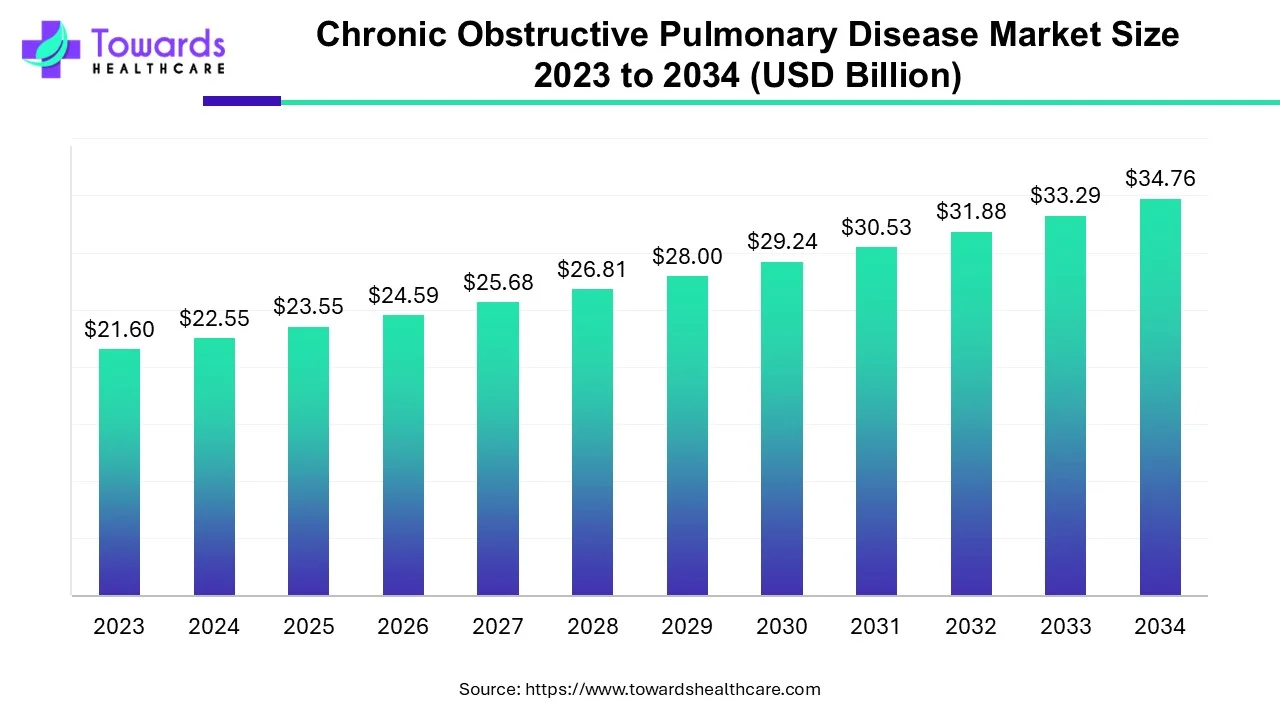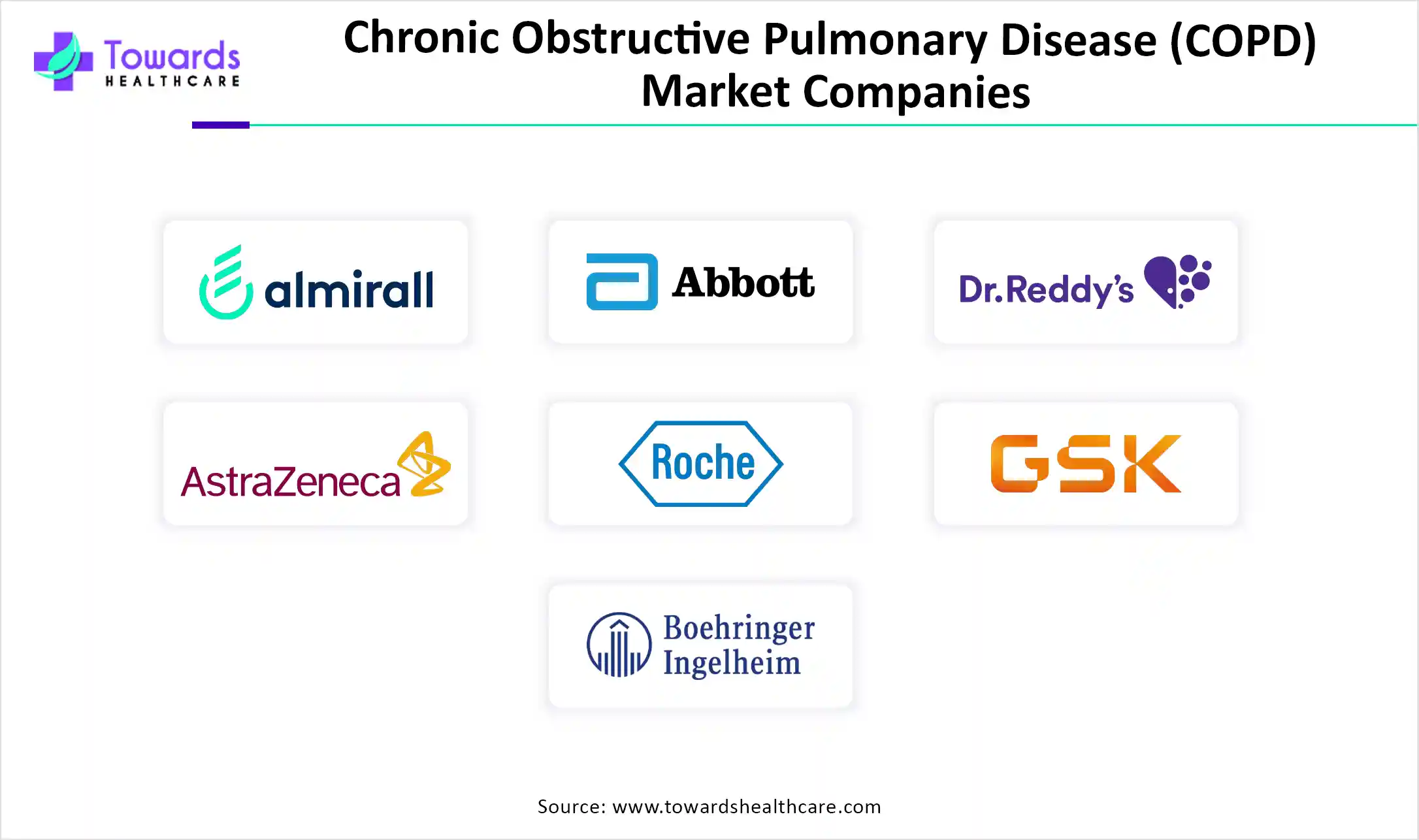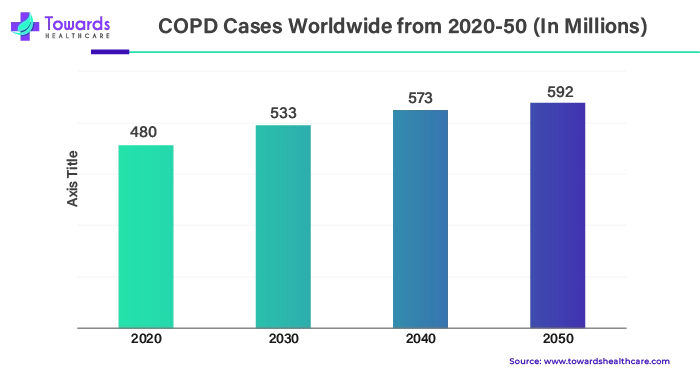April 2025

The chronic obstructive pulmonary disease market size is projected to reach USD 34.76 billion by 2034, growing from USD 23.55 billion in 2025, at a CAGR of 4.42% during the forecast period from 2025 to 2034.

The chronic obstructive pulmonary disease market revolves around all the aspects associated with COPD, which are research & development, drug development, process development, diagnosis, treatment, monitoring, and post-treatment care. Chronic obstructive lung disease, or COPD, is a common lung disorder that reduces airflow and causes breathing difficulties. COPD patients may develop lung damage or phlegm accumulation. The symptoms include coughing, wheezing, exhaustion, and sometimes even phlegm.
Tobacco and air pollution are the two primary causes of COPD. While there is no known treatment for COPD, a person's symptoms may improve if they give up smoking, shield themselves from air pollution, and become immunized to ward against infections. It can also be treated with oxygen, drugs, and pulmonary rehabilitation. Because chronic obstructive pulmonary disease cannot be cured and needs ongoing medication, therapy, and monitoring, the market for this condition is always expanding. The growing prevalence is also increasing due to the high amount of smoking, pollution, and occupational hazards.

| Company Name | AstraZeneca |
| Headquarters | Cambridge, United Kingdom |
| Pipeline | At ATS 2024 in May 2024, AstraZeneca showcased the power of its broad pipeline and portfolio by revealing the most recent research conducted on important respiratory and immune-mediated disorders. The firm focused on unmet needs in severe asthma, eosinophilic granulomatosis with polyangiitis (EGPA), and chronic obstructive pulmonary disease (COPD), as well as other chronic respiratory disorders, and presented 59 abstracts, including 12 late-breaking posters. |
| Company Name | Merck & Co., Inc. |
| Headquarters | New Jersey, U.S. |
| Pipeline | The study started in March 2023 and is currently in phase II, and the estimated completion date is March 2028. The aim of this research is to assess the safety and effectiveness of MK-5475 380 µg once daily oral inhalation dosage in individuals with PH-COPD (chronic obstructive pulmonary disease) aged 40 to 85 years (inclusive). The main hypothesis of the research is that at Week 24, the soluble Guanylate Cyclase (sGC) stimulator MK-5475 will increase 6MWD from baseline more effectively than a placebo. |

Day by day, the cases of COPD are increasing. The major causes of increasing cases are smoking and air pollution. According to the WHO, COPD is the 3rd leading cause of death across the world. 90% of deaths due to COPD occur in middle- and low-income countries, and smoking is responsible for 70% of COPD cases. Other factors that contribute to the prevalence of COPD are air pollution, occupational hazards, second-hand smoke, and genetic disorder (Alpha-1 antitrypsin deficiency). According to research published in the International Journal of COPD, 70-80% of cases get undiagnosed. However, with increasing research and development and technological advancements, the diagnosis of COPD is also increasing, which is driving the growth of the chronic obstructive pulmonary disease market.
The treatment cost of COPD is high due to several reasons. The condition is not curable and needs continuous monitoring, medication, and treatment. Acute COPD exacerbations account for most morbidity, death, and medical expenses; people who have these episodes frequently are known to fit the description of "frequent exacerbators." The expenditures of healthcare for COPD patients include medicines for maintenance therapy and outpatient care in addition to the treatment of exacerbations, such as hospital stays. This is the deadliest illness for which patients need to take anti-fibrotic medication. Immunosuppressive medications are required for this, which come with a lot of adverse effects and are costly. All this leads to the restraint of the chronic obstructive pulmonary disease market, especially in developing and underdeveloped countries.
For instance,
The development of novel biological therapeutics for COPD therapy is arguably the most talked-about development in this field. Treatment for many illnesses in humans has been transformed by the introduction of biologic treatments, such as monoclonal antibodies. Injectable drugs known as biologics are made from live cells or other biologic components and have the ability to target extremely particular immune pathways. There is reason to think that the medications that are now used to treat related respiratory disorders like asthma are going to make their way into the chronic obstructive pulmonary disease market.
For instance,
The chronic bronchitis segment dominated the market by disease type in 2023. Chronic bronchitis is a long-term bronchial irritation. It is one kind of COPD in which the lungs become irritated and mucus-filled. Although therapy is available, chronic bronchitis is an illness that never truly goes away. In the chronic obstructive pulmonary disease market, the emphysema sector is expanding rapidly in terms of disease type. Individuals with COPD who have between 27% and 35% CB. Some characteristics that may be associated with this phenomenon include maleness, age, a longer smoking history, more severe airway blockage, living in a rural area, and greater occupational exposures. Inhaled mucolytics and recombinant human DNase have not demonstrated significant potential. Currently under investigation as potential treatments for CB include oscillating positive expiratory pressure therapy, long-acting muscarinic antagonists, oral mucolytics and antioxidants, and quitting smoking. Targeted lung denervation, liquid nitrogen-metered cryospray, and rhinoplasty are therapy possibilities for CB.
By treatment type, the drugs segment dominated the chronic obstructive pulmonary disease market in 2023. In COPD treatment, drugs help manage symptoms and improve lung function. Bronchodilators, such as albuterol and tiotropium, help to open up the airways, making it easier to breathe. Corticosteroids reduce airway inflammation, while phosphodiesterase-4 inhibitors like roflumilast may help decrease exacerbations in severe COPD. These medications are often delivered through inhalers or nebulizers, targeting the lungs directly and minimizing systemic side effects. Compared to other treatment options like oxygen therapy or lung surgery, medications offer a less invasive and more convenient approach to managing COPD. Apart from this, COPD is a chronic disorder for which continuous medications are needed, and surgery and oxygen therapy are given in emergency situations.
By treatment type, the oxygen therapy segment is expected to grow at the fastest rate during the forecast period. In patients with severe resting hypoxemia and COPD, long-term oxygen treatment (LTOT) at home has been shown to enhance survival. Pharmacologic treatment for COPD often consists of long-term oxygen therapy (LTOT). Based on official statistics, it is estimated that over a million Medicare beneficiaries get oxygen delivered to their homes. In the United States, Medicare spends over $2 billion annually on this therapy.
By end-user, the hospital & clinics segment dominated the chronic obstructive pulmonary disease market in 2023. Adult COPD patients are frequently admitted to hospitals. This is mostly because individuals with COPD often experience increasing respiratory symptoms during the course of the disease, necessitating hospital admission in order to achieve clinical stability. COPD patients make up about 2% of all patients seen in hospital emergency rooms, and 40% of these patients require hospital admission. Apart from the recurrent hospital stays, another worrying finding is that 37% of COPD patients who were discharged from the hospital during the next ninety days needed to be readmitted, as per research by Pozo-Rodríguez et al. According to different research, between 10% and 20% of hospitalized patients were readmitted within 30 days, accounting for almost half of all hospital treatment due to COPD.
In 2023, North America dominated the chronic obstructive pulmonary disease market by region. The major countries contributing to the growth of the market are the U.S. and Canada. The U.S. has the highest share of the North American region. About 16 million persons in the United States have COPD, and many more do not realize they have the disease. Women make up more than half of individuals with diagnoses. According to the Centers for Disease Control and Prevention (CDC), COPD is the sixth most common cause of mortality in the U.S. and a major cause of disability. Over the next 20 years, it is anticipated that COPD expenses in the U.S. will rise to around $40 billion a year, or a total of $800 billion. To uncover undiagnosed COPD, screening and case-finding procedures have been used; case-finding has been suggested by the revised United States Preventive Services Task Force (USPTF) recommendation and the 2023 Global Initiative for Chronic Obstructive Lung Disease (GOLD) guideline.
By region, Asia Pacific is estimated to grow at the fastest rate during the forecast period. The major countries that contribute to the growth of the chronic obstructive pulmonary disease market in the region are India, China and Japan.
According to the most recent estimate, noncommunicable illnesses account for 66% of fatalities in India. About 8% of people in India have COPD. An estimated 37.8 million people in India are believed to have COPD, accounting for 17.8% of the global COPD burden. This country also contributes disproportionately to 27.3% of COPD fatalities and 28.5% of COPD DALYs worldwide, suggesting that COPD is not well managed in India. India has a larger case count of COPD than the global burden study, with an estimated 55 million cases, according to a meta-analysis. Asthma and COPD are projected to have cost India Rs. 60,000 crore in lost economic output, assuming that neither the government nor the medical community have specifically intervened in the previous ten years to significantly alter the way COPD is treated. Even in the event of a lower incidence rate, the staggering expense of treatment—487.2 billion—is incurred.
Nearly 100 million individuals in China suffer from COPD, making up nearly 25% of all cases worldwide. A national campaign to improve the use of pulmonary function testing and screening for those at high risk of COPD are two of the core goals of a countrywide intervention with integrated strategies and measurements addressing COPD treatment in primary health care, which is boosting the growth of the chronic obstructive pulmonary disease market in Asia Pacific. The Chinese government has made significant progress in improving primary health care's ability to screen for and treat COPD. This effort is in line with the goals of the WHO Global Action strategy for the prevention and control of noncommunicable diseases. It is part of China's medium- to long-term strategy for the prevention and treatment of chronic illnesses (2017–2025). More than 140,000 primary healthcare providers have gotten thorough training on pulmonary function testing between 2020 and 2023, strengthening their abilities to identify COPD in its early stages.
Disease Type
Treatment Type
End User Type
Region
April 2025
April 2025
June 2024
April 2025